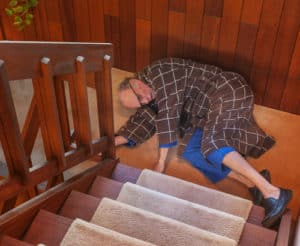We can help prevent falls in older people.

Key facts
1 in 3 people aged 65 years and over fall each year
Falls usually happen because gradual changes to our bodies make walking difficult, or they can be caused by hazards in and around the home.
Falls can cause hip fractures and other injuries that require lengthy hospital care and long-term effects.
60% of falls occur in the home
Falls are the leading cause of hospital admissions for older people
Falls can reduce mobility and independence
Remaining active can prevent you from falling.
What can you do to prevent falls?
Research has shown that it is possible to reduce the risk of tripping, slipping and falling by staying active and doing some simple exercises to improve your balance.
Exercise helps posture and balance
People with better posture, better balance and stronger muscles are much less likely to fall and therefore less likely to be injured. For example, women who sit for more than nine hours a day are more likely to have a hip fracture than those who sit for less than six hours a day. Some special exercise programs can reduce the risk of falling by about 20% and can also decrease serious injury from falls. These are programs for elderly people that are tailored to each older person’s needs, and include progressive muscle strengthening, improving balance and walking.
Source: arthritisnsw.org.au
Balance
Weak muscles, changes in blood pressure or heart rate, medications, ear problems and even a poor diet can all affect balance.
As well as regular exercise, you can improve balance if you:
Ask your podiatrist about exercises to improve balance, and make sure you have any foot pain dealt with
Maintain a healthy diet that includes fresh fruit and vegetables and calcium rich foods
Make sure you drink plenty of water each day
Consider a special ‘falls and balance’ program or class. You can search for one here
Other tips to prevent falls:
Around the home
Make sure mats, rugs and carpet edges are lying flat on the ground or remove them
Remove electrical cords from walking areas
Avoid walking on slippery or wet surfaces
Make sure rooms are well lit and free of clutter
Take care getting in and out of bed, go slowly, and use a bed frame if needed
Consider installing a hand rail on at least one side of any stairs, and next to baths, showers and toilets
Consider putting safety strips on edges of outdoor stairs
Beware of pets when you are moving around

Eyesight
Make sure your home is well lit so you can see where you are going at all times
Have your eyes tested every year by an optometrist
If you wear glasses, use them as directed. Be careful when going up and down stairs if you wear bifocals or trifocals
Wear sunglasses outside to minimize glare and squinting and to protect your eyes from UV damage.
Footwear
Wear shoes with a low broad heel, non-slip soles and good foot support.
The shoes should not be loose, and have laces or straps to keep them on.
Much of this information is from arthritisnsw.org.au where you will also find information about strength and balance exercises.
